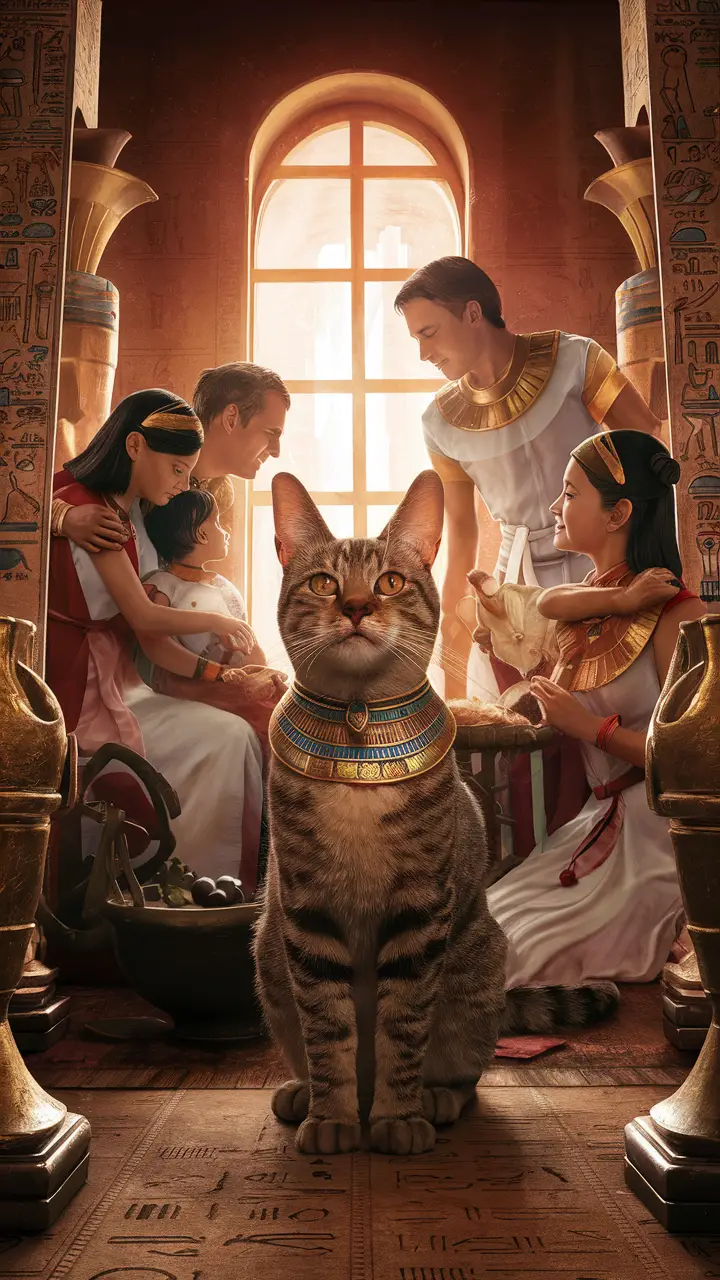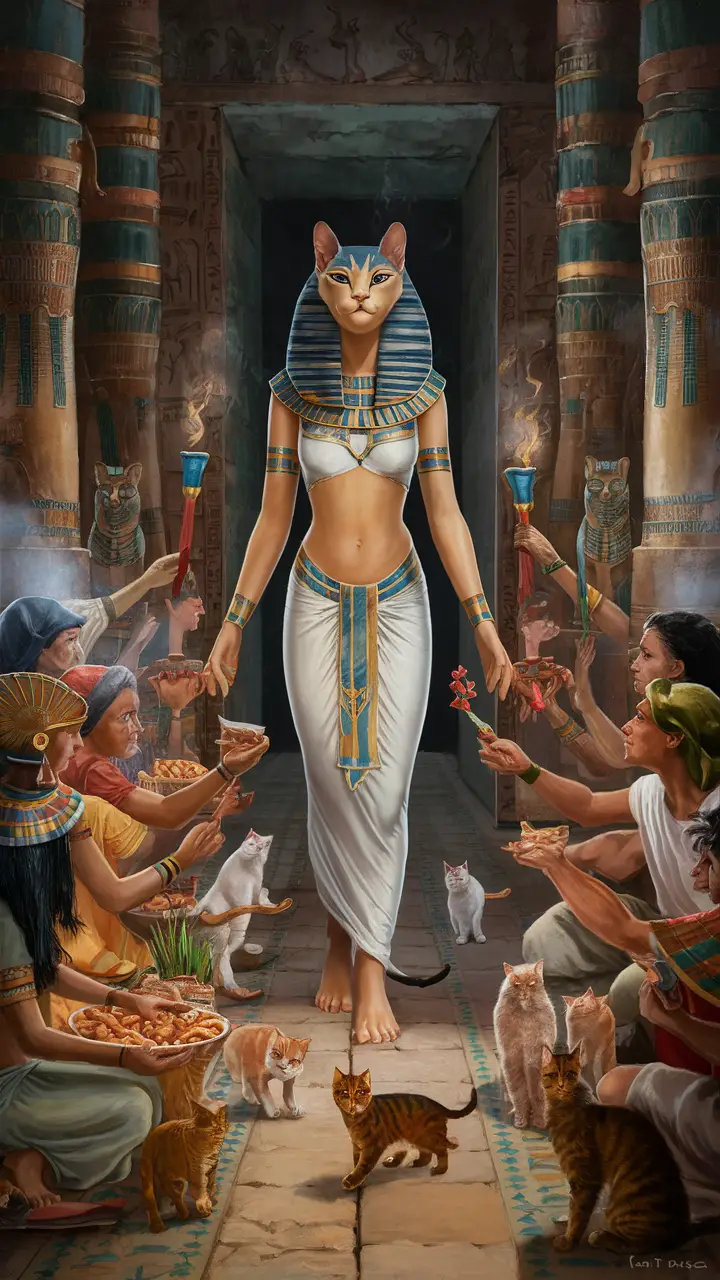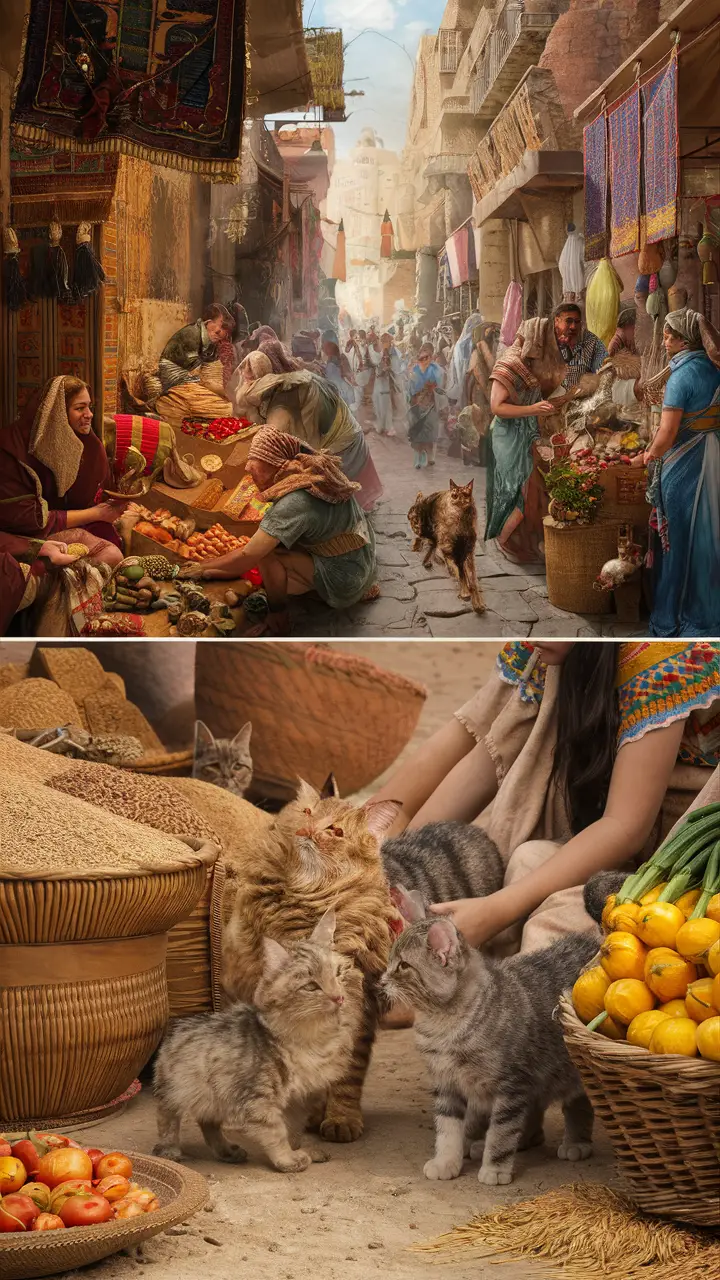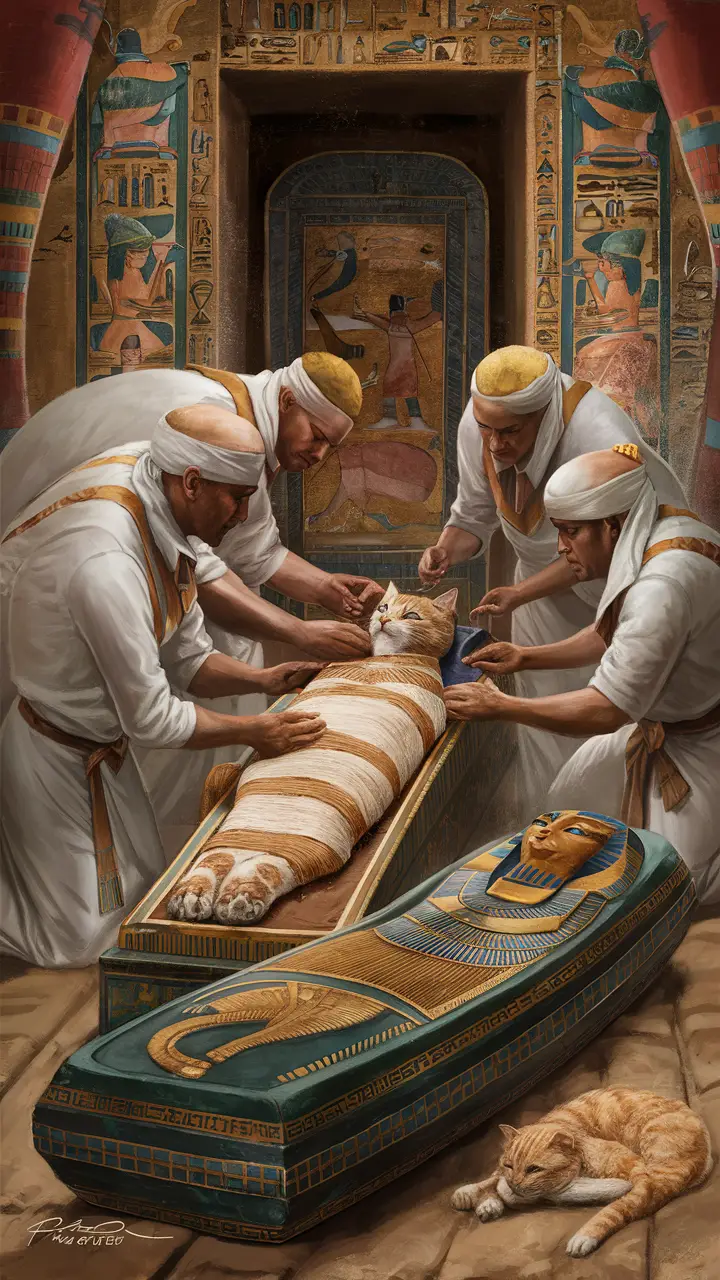- DHA, EPA & Vitamin E to Promote Healthy Skin
- Shiny Coat, Immune Support
- Heart Health and Joint Function
- 60 Count
Introduction
The reverence for cats in ancient Egypt is a profound chapter in human history, shedding light on their role as both guardians and esteemed members of society. These felines were seen as incarnations of divinity, closely linked with protection and royalty, particularly through their association with the goddess Bastet. Regarded as the protector of home and family, Bastet was often portrayed as a lioness or as a woman with the head of a lioness, making the domestic cat a ubiquitous and revered presence in many Egyptian households. This deep spiritual connection positioned cats as indispensable protectors against evil spirits, while also underscoring their importance in maintaining the household’s well-being.
Beyond their mystical roles, cats were integral to the daily and spiritual life in ancient Egypt, evidenced by practices such as mummification. Mummified cats, discovered in vast numbers, underscore their significance in religious rituals and their journey into the afterlife alongside their owners. Artifacts like the sarcophagus and votive offerings found in places such as the city of Bubastis—a prominent center for cat worship—highlight the cultural and religious devotion to these animals. The practice of shaving eyebrows in mourning a cat’s death, and the elaborate burials with precious metals, reflect the profound grief and respect bestowed upon cats, further solidifying their status within Egyptian society.
Key Takeaways
- Cats in ancient Egypt symbolized both protection and royalty, serving as earthly manifestations of the goddess Bastet and protectors of households.
- They played pivotal roles in religious rituals, embodying spirits of deities like Bastet and Ra, and were integral to ancient Egyptian religion and mythology.
- In art and literature, cats were celebrated for their elegance and depicted alongside pharaohs, underscoring their esteemed status in society.
- As practical household members, cats were crucial in pest control and provided companionship, enhancing the daily life and well-being of ancient Egyptians.
- Revered as sacred, cats were mummified and given elaborate burials, reflecting their deep cultural and spiritual significance.
- The enduring legacy of cats in Egyptian culture highlights their historical importance and continued reverence as symbols of good fortune and protection.
Cats as Symbols of Protection and Royalty

In ancient Egypt, domesticated cats transcended mere animal status to symbolize protection and royalty. This deep respect was closely tied to their relationship with Bastet, the deity recognized for her influence in home protection, fertility, and childbirth. Embodying Bastet’s essence, cats were essential in protecting households from both spiritual and physical disturbances, with their presence establishing them as both guardians and regal figures in ancient Egyptian culture, particularly during the new kingdom era.
Cats in Royal Iconography
Cats were not only pets but also regal symbols in ancient Egypt, frequently depicted alongside pharaohs in a variety of artistic expressions such as sculptures and paintings. These depictions underscored their status as symbols of majesty and power, integral to the identity of the ruling elite, particularly in contexts where gods chose to adopt their forms. The presence of cats in royal iconography, emphasizing their importance in conveying the sovereign’s divine right to rule, reflected the deep belief that ancient Egyptians believed cats were sacred.
Cats and Their Divine Connection
The spiritual significance of cats in ancient Egypt was deeply woven into the fabric of their religion. Cats were seen as physical manifestations of divine entities, especially the goddess Bastet. This connection granted them a sacred status, leading to their inclusion in religious rites and their presence in temples as holy creatures. The reverence afforded to cats is evident in the elaborate rituals surrounding their care, worship, and even mummification, illustrating how deeply ancient Egyptians revered cats.
Cats in Ancient Egyptian Religion and Mythology

Cats were venerated within ancient Egyptian religion and mythology, often depicted as sacred beings with a divine role. Their close ties with deities like Bastet and Ra, celebrated as gods and goddesses of ancient Egyptian life, underscored their integral presence in religious narratives and practices. This deep spiritual connection not only highlighted their divine attributes but also cemented their role in the societal and religious fabric of ancient Egypt, where they were viewed as worshipped as gods and found in the tombs of the Egyptian pantheon.
Key Aspects of Cats in Ancient Egyptian Culture
Symbols of Bastet Cats embodied the essence of Bastet, the goddess of home and fertility, believed to protect households from evil.
Royal Companions Often depicted alongside pharaohs, cats symbolized majesty and power, integral to royal iconography.
Protective Role Valued for keeping homes and granaries free of pests, cats were seen as guardians against evil spirits.
Religious Significance Cats were involved in religious rites and mummification, reflecting their sacred status and divine connection.
Guardians in the Temples
Cats were considered protectors within the sacred confines of Egyptian temples, embodying the protective spirit of the goddess Bastet. They were often found in temples dedicated to Bastet at Pelusium, where they roamed freely and were cared for by priests. This role was reflective of their broader religious significance as guardians against evil spirits, enhancing their sacred status among the Egyptians and showcasing how deeply ancient Egyptians also revered these cats of ancient Egypt.
Symbolic Messengers of the Gods
Beyond their protective roles, cats were also seen as messengers for the gods, especially for Ra, the sun god, symbolizing light and guardianship. They were believed to carry messages between the divine and the earthly realms, facilitating communication in religious rites. The depiction of Ra as a cat in many ancient artifacts, found in places like the Metropolitan Museum of Art, emphasizes their importance in conveying divine will and protection.
Cats in Art and Literature of Ancient Egypt
Cats held a significant place in ancient Egyptian art and literature, illustrating their pivotal role in cultural and religious life. These creatures, often depicted as Egyptian cats alongside pharaohs and deities in ancient Egypt, were not only appreciated for their physical attributes but also revered for their spiritual significance. Their frequent portrayal in various artistic mediums, whether as wild cats or domesticated cats, speaks volumes about their esteemed status and the multifaceted roles they played within society, deeply embedded in Egyptian history and role in Egyptian religion.
Cats and Their Divine Connection
| Spiritual Role | Description |
|---|---|
| Embodiment of Bastet | Cats were seen as physical manifestations of the goddess Bastet, leading to their revered status in temples and religious practices. |
| Protectors in Afterlife | Cats were mummified and placed in tombs to accompany their owners in the afterlife, symbolizing eternal guardianship. |
| Mourning Practices | The death of a cat was marked by significant mourning rituals, such as shaving eyebrows, indicating their deep emotional bond with humans. |
Feline Grace in Egyptian Art
Literary Symbols of Mystique and Power
Cats transcended their physical form in Egyptian literature, becoming symbols of mystique and power. They were frequently mentioned in myths and folklore, where their attributes were associated with magic and protection. The narratives often emphasized their intelligence and cunning, solidifying their status as creatures worthy of admiration and respect in the broad tapestry of Egyptian mythology.
The Role of Cats in Daily Life and Household

Cats were integral to the fabric of daily life in ancient Egypt, serving multifaceted roles within households and beyond. As natural pest controllers, they safeguarded the grain stores crucial to Egypt’s sustenance and economy, demonstrating their function of cats. Additionally, their presence in homes went beyond utilitarian purposes; they were cherished as pet cats, providing emotional support and enjoyment to their human counterparts, reinforcing the love of cats in Egyptian society.
Guardians of the Granary
Cats in ancient Egypt were esteemed for their ability to keep granaries free from rodents, a vital role given the central importance of grain to the Egyptian diet and economy. Their natural instincts not only protected the food supply but also prevented the spread of disease that could devastate populations. This pragmatic aspect of their presence underscored their value beyond mere pets, marking them as essential protectors of health and prosperity, as the cat became a symbol of guardianship.
Companions Beyond Utility
Beyond their role in pest control, cats were beloved as part of the family, often depicted in domestic scenes that highlight their role as cherished pets. Their playful and affectionate demeanor endeared them to individuals of all ages, making them a common subject in various forms of art and literature. The emotional bond formed between a mother cat and her kitten is a testament to the deep connection and mutual respect that characterized their relationship within ancient Egyptian households, reflecting the way cats were domesticated and cats were bred to be companions.
The Worship and Burial of Cats in Ancient Egypt

In ancient Egypt, cats were not only beloved pets but also revered as sacred animals closely linked to divine forces. The worship of these felines centered around the goddess Bastet, symbolizing protection and fertility, with cats treated as earthly representatives of her power. Their mummification and burial practices, a part of the domestication of the cat and mummies in ancient Egypt, further illustrate the profound respect and spiritual significance attributed to cats, ensuring their journey into the afterlife was marked with honor and reverence.
Rituals of Adoration
Worship of cats in ancient Egypt involved elaborate rituals and offerings to honor them as embodiments of the goddess Bastet. Temples dedicated to Bastet often housed cats in Egypt that were treated with the utmost respect and care, receiving offerings of food and incense to invoke divine favor. These practices not only reflect the religious importance of cats but also their integral role in the daily spiritual life of the Egyptians, bridging the gap between the celestial and the earthly, and even dress their cats for special ceremonies.
Sacred Burials
The burial of cats was taken very seriously, with ceremonies that mirrored those given to humans in their complexity and solemnity. When a cat died, they were often mummified and placed in special tombs or cemeteries designated for sacred animals, accompanied by grave goods that included food, amulets, and other valuable items to support their afterlife journey. This level of care in their burial practices highlights the ancient Egyptians’ belief in cats’ continued existence and their role in the spiritual realm, ensuring they were well-equipped for the world beyond. In some rituals, Egyptians would even shave their eyebrows to mourn the loss of a beloved feline companion.
“In ancient times cats were worshipped as gods; they have not forgotten this.” – Terry Pratchett
The Legacy of Cats in Ancient Egyptian Culture
The influence of cats in ancient Egypt remains potent and pervasive, resonating through centuries into modern Egypt. Their revered status as symbols of protection and good fortune persists, with cat statues prevalent in both traditional and contemporary settings to safeguard and bless homes. Moreover, the regal aura associated with cats continues to captivate, reflecting their historical connection with royalty and their celebrated grace and elegance, embodying the belief that ancient Egyptians revered cats.
Continuation of Worship Practices
The veneration of cats, deeply rooted in their association with the goddess Bastet, persists in various forms even today. Rituals and beliefs surrounding cats have evolved but still echo the ancient practices of worship through modern representations in art and culture. This ongoing adoration speaks volumes about their uninterrupted significance in Egyptian spirituality and societal norms, showing how past reverence shapes current cultural practices.
Modern Burial Customs
Echoing their ancient burial traditions, cats today are often given respectful farewells that mirror the practices of ancient Egypt. Many pet owners choose to mummify their cats or provide them with elaborate burial rites, underscoring the deep emotional connection between cats and their human companions. This practice not only honors their beloved pets but also pays homage to the historical and cultural importance of cats within ancient Egyptian society.
Conclusion
The profound impact of cats in ancient Egypt resonates through history, marking them as key cultural and religious figures. In every corner of ancient Egyptian society, from the humble home to grand tombs, cats were celebrated for their divine connections and protective powers. This reverence is captured in artifacts housed at institutions like the British Museum and reflects a society deeply intertwined with feline adoration. Whether through the roles of cat mummies found in the city of Bubastis or the depictions in the tomb of Nebamun, their legacy as symbols of protection and royalty is unmistakable.
Beyond the spiritual, the practical roles of cats in pest control and household companionship underline their integral place in daily life. This veneration extended into the afterlife, where cats were mummified and buried with honors akin to the highest echelons of society, signifying their perpetual significance. Their legacy, chronicled by historians like Herodotus and Diodorus Siculus, continues to influence the modern perception of cats, maintaining their status as cherished protectors and members of the family.
